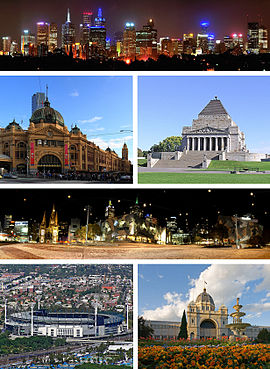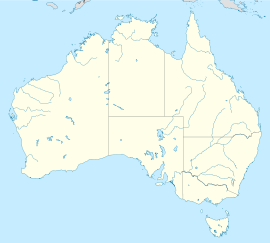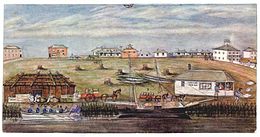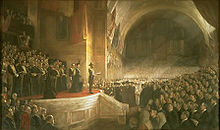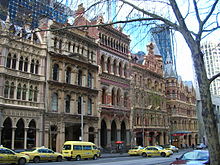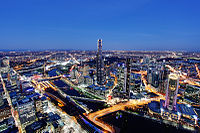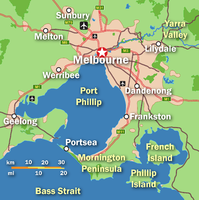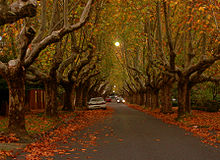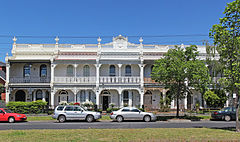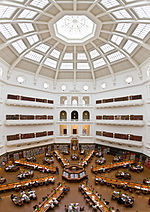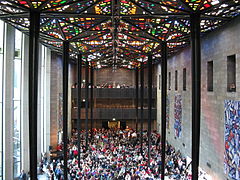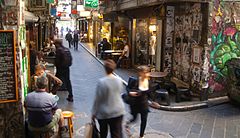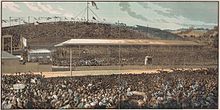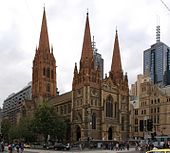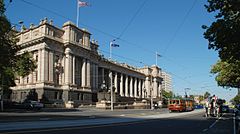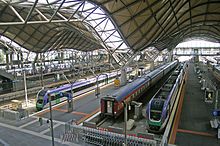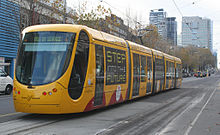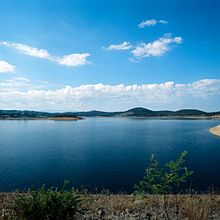
Melbourne
About this schools Wikipedia selection
SOS Children have produced a selection of wikipedia articles for schools since 2005. SOS Children has looked after children in Africa for forty years. Can you help their work in Africa?
Melbourne / ˈ m ɛ l b ər n / is the capital and most populous city in the state of Victoria, and the second most populous city in Australia. The Melbourne City Centre is the hub of the greater metropolitan area and the Census statistical division—of which "Melbourne" is the common name. As of June 2011, the greater geographical area had a population of 4.17 million. Inhabitants of Melbourne are called Melburnians. The metropolis is located on the large natural bay known as Port Phillip, with the city centre positioned on the estuary of the Yarra River (at the northernmost point of the bay). The metropolitan area then extends south from the city centre, along the eastern and western shorelines of Port Phillip, and expands into the hinterland. The city centre is situated in the municipality known as the City of Melbourne. The metropolitan area consists of a further 30 municipalities.
Melbourne was founded in 1835 (47 years after the European settlement of Australia) by settlers from Launceston in Van Diemen's Land. It was named by Governor of New South Wales Sir Richard Bourke in 1837, in honour of the British Prime Minister of the day, William Lamb, 2nd Viscount Melbourne. Melbourne was officially declared a city by Queen Victoria in 1847. In 1851, it became the capital city of the newly created colony of Victoria. During the Victorian gold rush of the 1850s, it was transformed into one of the world's largest and wealthiest cities. After the federation of Australia in 1901, it served as the interim seat of government of the newly created nation of Australia until 1927.
Often referred to as the "Garden City" and "cultural capital of Australia", Melbourne is the birthplace of cultural institutions such as Australian film (as well as the world's first feature film), Australian television, Australian rules football, the Australian impressionist art movement (known as the Heidelberg School) and Australian dance styles such as New Vogue and the Melbourne Shuffle. It is also a major centre for contemporary and traditional Australian music. Melbourne was ranked as the world's most liveable city in ratings published by the Economist Group's Intelligence Unit in August 2011 and again in 2012. It was also ranked in the top ten Global University Cities by RMIT's Global University Cities Index (since 2006) and the top 20 Global Innovation Cities by the 2thinknow Global Innovation Agency (since 2007). The metropolis is also home to the world's largest tram network. Melbourne Airport, the main passenger airport, is the second busiest in Australia and the Port of Melbourne is Australia's busiest seaport for containerised and general cargo.
History
Early history and foundation
Before the arrival of European settlers, the area was occupied for an estimated 31,000 to 40,000 years by under 20,000 hunter-gatherers from three indigenous regional tribes: the Wurundjeri, Boonwurrung and Wathaurong. The area was an important meeting place for the clans of the Kulin nation alliance and a vital source of food and water. The first European settlement in Victoria was established in 1803 on Sullivan Bay, near present-day Sorrento, but this settlement was abandoned due to a perceived lack of resources. It would be 30 years before another settlement was attempted.
In May and June 1835, the area which is now central and northern Melbourne was explored by John Batman, a leading member of the Port Phillip Association in Van Diemen's Land (now called Tasmania), who negotiated a purchase of 600,000 acres (2,400 km2) with eight Wurundjeri elders. Batman selected a site on the northern bank of the Yarra River, declaring that "this will be the place for a village". Batman then returned to Launceston in Tasmania. In early August 1835 a different group of settlers, including John Pascoe Fawkner, left Launceston on the ship Enterprize. John Pascoe Fawkner was forced to disembark at Georgetown, Tasmania because of outstanding debts. The remainder of the party continued and arrived at the mouth of the Yarra River on 15 August 1835. On 30 August 1835 the party disembarked and established a settlement at the site of the current Melbourne Immigration Museum. John Batman and his group arrived on 2 September 1835 and the two groups ultimately agreed to share the settlement.
Batman's Treaty with the Aborigines was annulled by the New South Wales government (which at the time governed all of eastern mainland Australia), which compensated the association. In 1836, Governor Bourke declared the city the administrative capital of the Port Phillip District of New South Wales, and commissioned the first plan for the city, the Hoddle Grid, in 1837. Later that year the settlement was named "Melbourne" after the British Prime Minister, William Lamb, 2nd Viscount Melbourne, whose seat was Melbourne Hall in the market town of Melbourne, Derbyshire. On 13 April 1837, the settlement's general post office was officially opened with that name.
Between 1836 and 1842, Victorian Aboriginal groups were largely dispossessed of territory bigger than England. By January 1844, there were said to be 675 Aborigines resident in squalid camps in Melbourne. Although the British Colonial Office appointed 5 "Aboriginal Protectors" for the entire Aboriginal population of Victoria, arriving in Melbourne in 1839, they worked ". . . within a land policy that nullified their work, and there was no political will to change this". "It was government policy to encourage squatters to take possession of whatever [Aboriginal] land they chose, . . . that largely explains why almost all the original inhabitants of Port Phillip's vast grasslands were dead so soon after 1835". By 1845, fewer than 240 wealthy Europeans held all the pastoral licences then issued in Victoria and became the patriarchs " . . . that were to wield so much political and economic power in Victoria for generations to come".
Melbourne was declared a city by letters patent of Queen Victoria, issued on 25 June 1847. The Port Phillip District became the separate Colony of Victoria in 1851, with Melbourne as its capital. With the Aboriginal population dispossessed of their lands and their management of fire having been disrupted for almost 15 years, the Colony experienced for the first time its largest-ever bushfires, burning about 25% of the land area of Victoria on Black Thursday on 6 February 1851.
Victorian gold rush
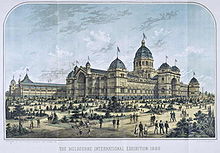
The discovery of gold in Victoria in 1851 led to the Victorian gold rush, and Melbourne, which served as the major port and provided most services for the region, experienced rapid growth. Within months, the city's population had increased by nearly three-quarters, from 25,000 to 40,000 inhabitants. Thereafter, growth was exponential and by 1865, Melbourne had overtaken Sydney as Australia's most populous city.
An influx of interstate and overseas migrants, particularly Irish, German and Chinese, saw the development of slums including a temporary "tent city" established on the southern banks of the Yarra. Chinese migrants founded a Chinatown in 1851, which remains the longest continuous Chinese settlement in the Western World. In the aftermath of the Eureka Rebellion, mass public support for the plight of the miners in Melbourne resulted in major political changes to the colony. The various nationalities involved in the Eureka Stockade revolt and Burke and Wills expedition give some indication of migration flows in the second half of the nineteenth century.
The population growth and flow of gold into the city helped stimulate a program of grand civic building beginning with the design and construction of many of Melbourne's surviving institutional buildings including Parliament House, the Treasury Building and Treasury Reserve, the Old Melbourne Gaol, Victoria Barracks, the State Library, Supreme Court, University, General Post Office, Government House, Customs House the Melbourne Town Hall, St Paul's, St Patrick's cathedrals and several major markets including the surviving Queen Victoria Market. The city's inner suburbs were planned, to be linked by boulevards and gardens. Melbourne had become a major finance centre, home to several banks, the Royal Mint to Australia's first stock exchange in 1861. Grand private buildings also were built in this era, including the Athenaeum Hall and several large hotels. The aboriginal population continued to decline with an estimated 80% total decrease by 1863, due primarily to introduced diseases, particularly smallpox, frontier violence and dispossession from their lands.
Land boom and bust
The economic boom of the Victorian gold rush peaked during the 1880s, by which time Melbourne had become the richest city in the world, and the largest after London in the British Empire. Melbourne hosted two international exhibitions at the large purpose-built Exhibition Building between 1880 and 1890, spurring the construction of several prestigious hotels including the Menzies, Federal and the Grand (Windsor).
In 1855 the Melbourne Cricket Club secured possession of its now famous ground, the MCG. Australian Football commenced in earnest about 1858, and Yarra rowing clubs and "regattas" became popular about the same time. In 1861 the Melbourne Cup was first run. In 1864 Melbourne acquired its first public monument—the Burke and Wills statue. In 1880 a telephone exchange was established and in the same year the foundations of St. Paul's Cathedral were laid; in 1881 electric light was installed in the Eastern Market building, and in the following year a generating station capable of supplying 2,000 incandescent lamps was in operation. In 1885 the first cable tram in Melbourne was built. Cable tramways were in general use until the 1920s, when they were superseded by electric motors. Electric trams were introduced into the suburbs in 1906.
During a visit in 1885 English journalist George Augustus Henry Sala coined the phrase "Marvellous Melbourne", which stuck long into the twentieth century and is still used today by Melburnians. Growing building activity culminated in a "land boom" which, in 1888, reached a peak of speculative development fuelled by consumer confidence and escalating land value. As a result of the boom, large commercial buildings, coffee palaces, terrace housing and palatial mansions proliferated in the city. The establishment of a hydraulic facility in 1887 allowed for the local manufacture of elevators, resulting in the first construction of high-rise buildings; most notably 1889's APA (The Australian) Building, the world's tallest office building upon completion and Melbourne's tallest for over half a century. This period also saw the expansion of a major radial rail-based transport network.
A brash boosterism that had typified Melbourne during this time ended in 1891 with a severe depression of the city's economy, sending the local finance and property industries into a period of chaos during which 16 small banks and building societies collapsed and 133 limited companies went into liquidation. The Melbourne financial crisis was a contributing factor in the Australian economic depression of the 1890s and the Australian banking crisis of 1893. The effects of the depression on the city were profound, although it recovered enough to grow slowly during the early twentieth century.
Federation of Australia
At the time of Australia's federation on 1 January 1901, Melbourne became the seat of government of the federation. The first federal parliament was convened on 9 May 1901 in the Royal Exhibition Building, subsequently moving to the Victorian Parliament House where it was located until 1927, when it was moved to Canberra. The Governor-General of Australia resided at Government House in Melbourne until 1930 and many major national institutions remained in Melbourne well into the twentieth century.
Post-war period
In the immediate years after World War II, Melbourne expanded rapidly, its growth boosted by Post war immigration to Australia, primarily from Southern Europe and the Mediterranean. While the "Paris End" of Collins Street began Melbourne's boutique shopping and open air cafe cultures, the city centre was seen by many as stale, the dreary domain of office workers, something expressed by John Brack in his famous painting Collins St., 5 pm (1955).
Height limits in the Melbourne CBD were lifted in 1958, after the construction of ICI House, transforming the city's skyline with the introduction of skyscrapers. Suburban expansion then intensified, serviced by new indoor malls beginning with Chadstone Shopping Centre. The post-war period also saw a major renewal of the CBD and St Kilda Road which significantly modernised the city. New fire regulations and redevelopment saw most of the taller pre-war CBD buildings either demolished or partially retained through a policy of facadism. Many of the larger suburban mansions from the boom era were also either demolished or subdivided.
To counter the trend towards low-density suburban residential growth, the government began a series of controversial public housing projects in the inner city by the Housing Commission of Victoria, which resulted in demolition of many neighbourhoods and a proliferation of high-rise towers. In later years, with the rapid rise of motor vehicle ownership, the investment in freeway and highway developments greatly accelerated the outward suburban sprawl and declining inner city population. The Bolte government sought to rapidly accelerate the modernisation of Melbourne. Major road projects including the remodelling of St Kilda Junction, the widening of Hoddle Street and then the extensive 1969 Melbourne Transportation Plan changed the face of the city into a car-dominated environment.
Australia's financial and mining booms between 1969 and 1970 resulted in establishment of the headquarters of many major companies ( BHP Billiton and Rio Tinto, among others) in the city. Nauru's then booming economy resulted in several ambitious investments in Melbourne, such as Nauru House. Melbourne remained Australia's main business and financial centre until the late 1970s, when it began to lose this primacy to Sydney.
As the centre of Australia's " rust belt", Melbourne experienced an economic downturn between 1989 to 1992, following the collapse of several local financial institutions. In 1992 the newly elected Kennett government began a campaign to revive the economy with an aggressive development campaign of public works coupled with the promotion of the city as a tourist destination with a focus on major events and sports tourism. During this period the Australian Grand Prix moved to Melbourne from Adelaide. Major projects included the construction of a new facility for the Melbourne Museum, Federation Square, the Melbourne Exhibition and Convention Centre, Crown Casino and the CityLink tollway. Other strategies included the privatisation of some of Melbourne's services, including power and public transport, and a reduction in funding to public services such as health, education and public transport infrastructure.
Contemporary Melbourne
Since the mid-1990s, Melbourne has maintained significant population and employment growth. There has been substantial international investment in the city's industries and property market. Major inner-city urban renewal has occurred in areas such as Southbank, Port Melbourne, Melbourne Docklands and more recently, South Wharf. According to the Australian Bureau of Statistics, Melbourne sustained the highest population increase and economic growth rate of any Australian capital city in the three years ended June 2004. These factors have led to population growth and further suburban expansion through the 2000s.
From 2006, the growth of the city extended into "green wedges" and beyond the city's urban growth boundary. Predictions of the city's population reaching 5 million people pushed the state government to review the growth boundary in 2008 as part of its Melbourne @ Five Million strategy. In 2009, Melbourne was less affected by the Late-2000s financial crisis in comparison to other Australian cities. At this time, more new jobs were created in Melbourne than any other Australian capital—almost as many as the next two fastest growing cities, Brisbane and Perth, combined, and Melbourne's property market remained strong, resulting in historically high property prices and widespread rent increases.
Geography
Topography
Melbourne is located in the south-eastern part of mainland Australia, within the state of Victoria. Geologically, it is built on the confluence of Quaternary lava flows to the west, Silurian mudstones to the east, and Holocene sand accumulation to the southeast along Port Phillip. The southeastern suburbs are situated on the Selwyn fault which transects Mount Martha and Cranbourne.
Melbourne extends along the Yarra River towards the Yarra Valley and the Dandenong Ranges to the east. It extends northward through the undulating bushland valleys of the Yarra's tributaries— Moonee Ponds Creek (toward Tullamarine Airport), Merri Creek, Darebin Creek and Plenty River—to the outer suburban growth corridors of Craigieburn and Whittlesea.
The city reaches south-east through Dandenong to the growth corridor of Pakenham towards West Gippsland, and southward through the Dandenong Creek valley, the Mornington Peninsula and the city of Frankston taking in the peaks of Olivers Hill, Mount Martha and Arthurs Seat, extending along the shores of Port Phillip as a single conurbation to reach the exclusive suburb of Portsea and Point Nepean. In the west, it extends along the Maribyrnong River and its tributaries north towards Sunbury and the foothills of the Macedon Ranges, and along the flat volcanic plain country towards Melton in the west, Werribee at the foothills of the You Yangs granite ridge and Geelong as part of the greater metropolitan area to the south-west.
Melbourne's major bayside beaches are located in the south-eastern suburbs along the shores of Port Phillip Bay, in areas like Port Melbourne, Albert Park, St Kilda, Elwood, Brighton, Sandringham, Mentone and Frankston although there are beaches in the western suburbs of Altona and Williamstown. The nearest surf beaches are located 85 kilometres (53 mi) south-east of the Melbourne CBD in the back-beaches of Rye, Sorrento and Portsea.
Melbourne is also the world's 25th largest city by land-mass, following St. Louis, Moscow and Pittsburgh, at 2,080 square kilometers.
Climate
Melbourne has a moderate oceanic climate ( Köppen climate classification Cfb) and is well known for its changeable weather conditions. This is mainly due to Melbourne's location situated on the boundary of the very hot inland areas and the cold southern ocean. This temperature differential is most pronounced in the spring and summer months and can cause very strong cold fronts to form. These cold fronts can be responsible for all sorts of severe weather from gales to severe thunderstorms and hail, large temperature drops, and heavy rain.
Port Phillip is often warmer than the surrounding oceans and/or the land mass, particularly in spring and autumn; this can set up a "bay effect" similar to the " lake effect" seen in the United States where showers are intensified leeward of the bay. Relatively narrow streams of heavy showers can often affect the same places (usually the eastern suburbs) for an extended period of time, while the rest of Melbourne and surrounds stays dry. Overall, Melbourne is, owing to the rain shadow of the Otway Ranges, nonetheless drier than average for southern Victoria. Within the city and surrounds, however, rainfall varies widely, from around 425 millimetres (17 in) at Little River to 1,250 millimetres (49 in) on the eastern fringe at Gembrook.
Melbourne is also prone to isolated convective showers forming when a cold pool crosses the state, especially if there is considerable daytime heating. These showers are often heavy and can contain hail and squalls and significant drops in temperature, but they pass through very quickly at times with a rapid clearing trend to sunny and relatively calm weather and the temperature rising back to what it was before the shower. This occurs often in the space of minutes and can be repeated many times in a day, giving Melbourne a reputation for having "four seasons in one day", a phrase that is part of local popular culture and familiar to many visitors to the city.
Melbourne is colder than other mainland Australian state capital cities in the winter. The lowest temperature on record is −2.8 °C (27.0 °F), on 4 July 1901. However, snowfalls are rare: the most recent occurrence of sleet in the CBD was on 25 July 1986 and the most recent snowfalls in the outer eastern suburbs and Mount Dandenong were on 10 August 2005. More commonly, Melbourne experiences frosts and fog in winter.
Melbourne summers are notable for occasional days of extreme heat. This occurs when the synoptic pattern is conducive to the transportation of very hot air from central Australia over to the south east corner of the continent. The inland deserts of Australia are amongst the hottest areas on earth, particularly the inland parts of north-west Australia. Every summer, intense heat builds starting in the Pilbara district of Western Australia around October/November and spreading widely over the tropical and subtropical inland parts of the continent by January. In the summer months, the southern part of the continent straddles the westerly wind belt to the south and the subtropical high pressure ridge to the north. The intense heat buildup occurs where high pressure is highly dominant in the upper levels of the atmosphere over the tropics and subtropics of Australia in summer allowing for a huge area of stable atmospheric conditions to predominate. On occasion a strong cold front will develop in summer and bring the westerlies further north than their mean summer position. On these occasions, north-west winds will develop ahead of the cold front's passage and sometimes these can be very strong, even gale force. When this occurs the hot air from the inland is dragged right down over south east Australia, occasionally even as far as southern Tasmania. As this air mass is carried entirely over the continental land mass it remains unmodified, i.e. it does not pick up additional moisture from a body of water and retains most if not all of its heat. On these occasions, the normally temperate parts of southern Victoria, including Melbourne, can experience the full fury of the desert climate albeit only briefly as the cold front responsible usually passes through relatively quickly allowing cool southerly winds from the southern ocean to replace the hot desert air. The highest temperature recorded in Melbourne city was 46.4 °C (115.5 °F), on 7 February 2009.
| Climate data for Melbourne | |||||||||||||
|---|---|---|---|---|---|---|---|---|---|---|---|---|---|
| Month | Jan | Feb | Mar | Apr | May | Jun | Jul | Aug | Sep | Oct | Nov | Dec | Year |
| Record high °C (°F) | 45.6 (114.1) |
46.4 (115.5) |
41.7 (107.1) |
34.9 (94.8) |
28.7 (83.7) |
22.4 (72.3) |
23.1 (73.6) |
26.5 (79.7) |
31.4 (88.5) |
36.9 (98.4) |
40.9 (105.6) |
43.7 (110.7) |
46.4 (115.5) |
| Average high °C (°F) | 25.9 (78.6) |
25.8 (78.4) |
23.9 (75) |
20.3 (68.5) |
16.7 (62.1) |
14.1 (57.4) |
13.5 (56.3) |
15.0 (59) |
17.2 (63) |
19.7 (67.5) |
22.0 (71.6) |
24.2 (75.6) |
19.9 (67.8) |
| Average low °C (°F) | 14.3 (57.7) |
14.6 (58.3) |
13.2 (55.8) |
10.8 (51.4) |
8.6 (47.5) |
6.9 (44.4) |
6.0 (42.8) |
6.7 (44.1) |
8.0 (46.4) |
9.5 (49.1) |
11.2 (52.2) |
12.9 (55.2) |
10.2 (50.4) |
| Record low °C (°F) | 5.5 (41.9) |
4.5 (40.1) |
2.8 (37) |
1.5 (34.7) |
−1.1 (30) |
−2.2 (28) |
−2.8 (27) |
−2.1 (28.2) |
−0.5 (31.1) |
0.1 (32.2) |
2.5 (36.5) |
4.4 (39.9) |
−2.8 (27) |
| Rainfall mm (inches) | 47.6 (1.874) |
48.0 (1.89) |
50.3 (1.98) |
57.4 (2.26) |
55.8 (2.197) |
49.0 (1.929) |
47.5 (1.87) |
50.0 (1.969) |
58.1 (2.287) |
66.4 (2.614) |
60.4 (2.378) |
59.5 (2.343) |
650.0 (25.591) |
| Avg. rainy days | 8.4 | 7.5 | 9.4 | 11.8 | 14.6 | 15.4 | 16.1 | 16.1 | 14.9 | 14.2 | 11.8 | 10.4 | 150.6 |
| Mean monthly sunshine hours | 279.0 | 234.9 | 210.8 | 168.0 | 120.9 | 108.0 | 114.7 | 145.7 | 171.0 | 195.3 | 210.0 | 232.5 | 2,190.8 |
| Source: Bureau of Meteorology" | |||||||||||||
Urban structure
The centre of Melbourne's central business district is formed by the Hoddle Grid (dimensions of 1 by 0.5 miles (1.6 by 0.80 km)). The grid's southern edge fronts onto the Yarra River. Office, commercial and public developments in the adjoining districts of Southbank and Docklands have made these redeveloped areas into extensions of the CBD in all but name. The city centre is well known for its historic and prominent lanes and arcades (the most notable of which are Block Place and Royal Arcade) which contain a variety of shops and cafés and are a byproduct of the city's layout.
Melbourne's CBD, compared with other Australian cities, has comparatively unrestricted height limits and as a result of waves of post-war development contains five of the six tallest buildings in Australia, the tallest of which is the Eureka Tower, situated in Southbank. It has an observation deck near the top from where you can see above all of Melbourne's structures. The Rialto tower, the city's second tallest, remains the tallest building in the old CBD; its observation deck for visitors has recently closed.
The CBD and surrounds also contain many significant historic buildings such as the Royal Exhibition Building, the Melbourne Town Hall and Parliament House. Although the area is described as the centre, it is not actually the demographic centre of Melbourne at all, due to an urban sprawl to the south east, the demographic centre being located at Glen Iris.
Melbourne is typical of Australian capital cities in that after the turn of the 20th century, it expanded with the underlying notion of a 'quarter acre home and garden' for every family, often referred to locally as the Australian Dream. This, coupled with the popularity of the private automobile after 1945, led to the auto-centric urban structure now present today in the middle and outer suburbs. Much of metropolitan Melbourne is accordingly characterised by low density sprawl, whilst its inner city areas feature predominantly medium-density, transit-oriented urban forms. The city centre, Docklands, St. Kilda Road and Southbank areas feature high-density forms.
Melbourne is often referred to as Australia's garden city, and the state of Victoria was once known as the garden state. There is an abundance of parks and gardens in Melbourne, many close to the CBD with a variety of common and rare plant species amid landscaped vistas, pedestrian pathways and tree-lined avenues. There are also many parks in the surrounding suburbs of Melbourne, such as in the municipalities of Stonnington, Boroondara and Port Phillip, south east of the central business district. The extensive area covered by urban Melbourne is formally divided into hundreds of suburbs (for addressing and postal purposes), and administered as local government areas 31 of which are located within the metropolitan area.
Housing
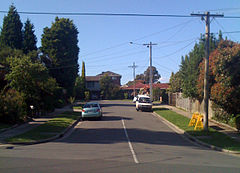
Housing in Melbourne is characterised by minimal and lack of public housing and high demand for, and largely unaffordable, rental housing. Public housing is usually provided by the Housing Commission of Victoria and operates within the framework of the Commonwealth-State Housing Agreement, by which funding for public housing is provided by both federal and state governments.
At present, Melbourne is experiencing high population growth, generating high demand for housing. This has created a housing boom, pushing housing prices up and having an effect on rental prices as well as availability of all types of housing. Subdivision regularly occurs in the far outer areas of Melbourne with Display homes from numerous developers offering house and land packages.
Environment
Like many urban environments, Melbourne faces some significant environmental issues, many of them relating to the city's large urban footprint and urban sprawl and the demand for infrastructure and services. One such issue is water usage, drought and low rainfall. Drought in Victoria, low rainfalls and high temperatures deplete Melbourne water supplies and climate change may have a long-term impact on the water supplies of Melbourne. Melbourne has been in a drought since 1997. In response to low water supplies and low rainfall due to drought, the government implemented water restrictions and a range of other options including: water recycling schemes for the city, incentives for household water tanks, greywater systems, water consumption awareness initiatives, and other water saving and reuse initiatives; also, in June 2007, the Bracks Government announced that a $3.1 billion Wonthaggi desalination plant would be built on Victoria's south-east coast, capable of treating 150 billion litres of water per year, as well as a 70 km (43 mi) pipeline from the Goulburn area in Victoria's north to Melbourne and a new water pipeline linking Melbourne and Geelong. Both projects are being conducted under controversial Public-Private Partnerships and a multitude of independent reports have found that neither project is required to supply water to the city and that Sustainable Water Management is the best solution. In the meantime, the drought must be weathered.
In response to Attribution of recent climate change, the City of Melbourne, in 2002, set a target to reduce carbon emissions to net zero by 2020 and Moreland City Council established the Zero Moreland program, however not all metropolitan municipalities have followed, with the City of Glen Eira notably deciding in 2009 not to become carbon neutral. Melbourne has one of the largest urban footprints in the world due to its low density housing, resulting in a vast suburban sprawl, with a high level of car dependence and minimal public transport outside of inner areas. Much of the vegetation within the city are non-native species, most of European origin, and in many cases plays host to invasive species and noxious weeds. Significant introduced urban pests include the Common Myna, Feral Pigeon, Brown Rat, European Wasp, Common Starling and Red Fox. Many outlying suburbs, particularly towards the Yarra Valley and the hills to the north-east and east, have gone for extended periods without regenerative fires leading to a lack of saplings and undergrowth in urbanised native bushland. The Department of Sustainability and Environment partially addresses this problem by regularly burning off. Several national parks have been designated around the urban area of Melbourne, including the Mornington Peninsula National Park, Port Phillip Heads Marine National Park and Point Nepean National Park in the south east, Organ Pipes National Park to the north and Dandenong Ranges National Park to the east. There are also a number of significant state parks just outside Melbourne. Responsibility for regulating pollution falls under the jurisdiction of the EPA Victoria and several local councils. Air pollution, by world standards, is classified as being good. Summer and autumn are the worst times of year for atmospheric haze in the urban area.
Another recent environmental issue in Melbourne was the Victorian government project of channel deepening Melbourne Ports by dredging Port Phillip Bay—the Port Phillip Channel Deepening Project. It was subject to controversy and strict regulations among fears that beaches and marine wildlife could be affected by the disturbance of heavy metals and other industrial sediments. Other major pollution problems in Melbourne include levels of bacteria including E. coli in the Yarra River and its tributaries caused by septic systems, as well as litter. Up to 350,000 cigarette butts enter the storm water runoff every day. Several programs are being implemented to minimise beach and river pollution. In February 2010, The Transition Decade, an initiative to transition human society, economics and environment towards sustainability, was launched in Melbourne.
Culture
Melbourne is an international cultural centre, with cultural endeavours spanning major events and festivals, drama, musicals, comedy, music, art, architecture, literature, film and television. Melbourne is the birthplace of Australian film and television, Australian rules football, the Heidelberg School of Australian Impressionism, Australian contemporary dance (including the Melbourne Shuffle and New Vogue styles), and is home to the National Gallery of Victoria, Australia's oldest and largest public art museum. In 2008, Melbourne became the second city after Edinburgh to be declared a UNESCO City of Literature. It has thrice shared top position in a survey by The Economist of the world's most liveable cities on the basis of a number of attributes which include its broad cultural offerings.
Festivals
The city celebrates a wide variety of annual cultural events and festivals of all types, including Australia's largest free community festival— Moomba, the Melbourne International Arts Festival, Melbourne International Film Festival, Melbourne International Comedy Festival and the Melbourne Fringe Festival.
Live performance
The Australian Ballet is based in Melbourne, as is the Melbourne Symphony Orchestra. Melbourne is the second home of Opera Australia after it merged with "Victoria State Opera" in 1996. The Victorian Opera had its inaugural season in 2006 and operates out of various venues in Melbourne.
Notable theatres and performance venues include the Victorian Arts Centre (which includes the State Theatre, Hamer Hall, the Playhouse and the Fairfax Studio), Melbourne Recital Centre, Sidney Myer Music Bowl, Princess Theatre, Regent Theatre, Forum Theatre, Palace Theatre, Comedy Theatre, Athenaeum Theatre, Her Majesty's Theatre, Capitol Theatre, Palais Theatre and the Australian Centre for Contemporary Art.
Film
The city has an extensive cinematic history. Indeed, the world's first feature films were produced in Melbourne and its outer suburbs. Limelight Department's 1900 Soldiers of the Cross, the world's first religious epic, anticipated the early 1900s golden age of Melbourne film production—an era marked by the exploration of local history and Australia's emerging identity. The 1854 civil insurrection of Ballarat was brought to life on the screen in Eureka Stockade, and The Story of the Kelly Gang (the world's first feature length narrative film and precedent of the " Bushranging drama") followed the escapades of Ned Kelly and his gang of outlaws. Melbourne filmmakers continued to produce bushranger and convict films, such as 1907's Robbery Under Arms and 1908's For the Term of His Natural Life, up until 1912, when Victorian politicians banned the screening of bushranger films for what they perceived as the promotion of crime.
Melbourne's and Australia's film industries declined soon after and came to a virtual stop in the 1960s. A notable film shot and set in Melbourne during this lull is 1959's On the Beach. The 1970s saw a major renaissance of Australian film, giving rise to the Australian New Wave, as well as the Ocker and Ozploitation genres, instigated by Melbourne-based productions Stork and Alvin Purple respectively. Other 1970s Melbourne films, such as Picnic at Hanging Rock and Mad Max, would achieve worldwide acclaim. 2004 saw the construction of Melbourne's largest film and television studio complex, Docklands Studios Melbourne, which has hosted many domestic films and television shows, as well as international features Ghost Rider, Knowing, Charlotte's Web, Nightmares and Dreamscapes and Where the Wild Things Are, among others. Melbourne is also home to the headquarters of Village Roadshow Pictures, Australia's largest film production company. Famous modern day actors from Melbourne include Cate Blanchett, Rachel Griffiths, Olivia Newton-John, Guy Pearce and Eric Bana.
Street culture
Melbourne has been placed alongside New York and Berlin as one of the world's great street art meccas, and its extensive street art-laden laneways, alleys and arcades were voted by Lonely Planet readers as Australia's top cultural attraction.
Architecture
The city is recognised for its mix of modern architecture which intersects with an extensive range of nineteenth and early twentieth century buildings. Some of the most architecturally noteworthy historic buildings include the World Heritage Site-listed Royal Exhibition Building, constructed over a two-year period for the Melbourne International Exhibition in 1880, A.C. Goode House, a Gothic style building located in Collins Street designed by Wright, Reed & Beaver (1891), William Pitt's Venetian Gothic style Old Stock Exchange (1888), William Wardell's Gothic Bank (1883) which features some of Melbourne's finest interiors, the incomplete Parliament House, St Paul's Cathedral (1891) and Flinders Street Station (1909), the busiest commuter railway station in the world in the mid-1920s.
The city also features the Shrine of Remembrance which was built as a memorial to the men and women of Victoria who served in World War I and is now a memorial to all Australians who have served in war. The now demolished Queen Anne style APA Australian Building (1889), the world's 3rd tallest building at the time of completion, is said to have anticipated the skyscraper race in New York City and Chicago.
As of 2012, the city contains a total of 594 high-rise buildings, with 8 under construction, 71 planned and 39 at proposal stage making the city's skyline, the second largest in Australia. The CBD is dominated by modern office buildings including the Rialto Towers (1986), built on the site of several grand classical Victorian buildings, two of which—the Rialto Building (1889) designed by William Pitt and the Winfield Building (1890) designed by Charles DEbro & Richard Speight—still remain today and more recently hi-rise apartment buildings including Eureka Tower (2006), the 10th tallest residential building in the world.
Residential architecture is not defined by a single architectural style, but rather an eclectic mix of modern free-standing dwellings in the metropolitan area (particularly in areas of urban sprawl) which is perhaps the most common type of housing outside inner Melbourne, Victorian terrace housing, townhouses and historic Italianate, Tudor revival and Neo-Georgian mansions common in neighbourhoods such as Toorak.
Sport

Melbourne is notable as the host city for the 1956 Summer Olympic Games (the first Olympic Games held in the southern hemisphere), along with the 2006 Commonwealth Games. The city is home to three major annual international sporting events: the Australian Open (one of the four Grand Slam tennis tournaments); the Melbourne Cup (horse racing); and the Australian Grand Prix (Formula One). Melbourne was proclaimed the "World's Ultimate Sports City", in 2008, for the second time. The city is home to the National Sports Museum, which until 2003 was located outside the members pavilion at the Melbourne Cricket Ground. It reopened in 2008 in the Olympic Stand.
Australian rules football and cricket are the most popular sports in Melbourne. It is considered the spiritual home of the two sports in Australia. The first official cricket Test match was played at the Melbourne Cricket Ground in March 1877. The first recorded Australian rules football match was played in Melbourne in 1858. The Australian Football League is headquartered at Docklands Stadium. Nine of the League's teams are based in the Melbourne metropolitan area. Up to five AFL matches are played each week in Melbourne, attracting an average 40,000 people per game. Additionally, the city annually hosts the AFL Grand Final.
The city is home to many professional franchises/teams in national competitions including: cricket clubs Melbourne Stars, Melbourne Renegades and Victorian Bushrangers, which play in the Big Bash League and other domestic cricket competitions; soccer clubs Melbourne Victory and Melbourne Heart, which play in the A-League competition; rugby league club Melbourne Storm which plays in the NRL competition; rugby union club Melbourne Rebels, which plays in the Super Rugby competition; netball club Melbourne Vixens, which plays in the trans-Tasman trophy ANZ Championship; basketball club Melbourne Tigers, which plays in the NBL competition; Bulleen Boomers and Dandenong Rangers, which play in the WNBL; ice hockey teams Melbourne Ice and Melbourne Mustangs, who play in the Australian Ice Hockey League; and baseball club Melbourne Aces, which plays in the Australian Baseball League. Rowing is also a large part of Melbourne's sporting identity, with a number of clubs located on the Yarra River, out of which many Australian Olympians trained.
In November 2008, it was announced that the Victorian Major Events Company had informed the Australian Olympic Committee that Melbourne was considering making bids for either the 2024 or 2028 Summer Olympics.
Economy
Melbourne has a highly diversified economy with particular strengths in finance, manufacturing, research, IT, education, logistics and transportation and tourism. Melbourne is headquarters for many of Australia's largest corporations, including five of the ten largest in the country (based on revenue), and five of the largest six in the country (based on market capitalisation) ( ANZ, BHP Billiton (the world's largest mining company), the National Australia Bank, Rio Tinto and Telstra); as well as such representative bodies and thinktanks as the Business Council of Australia and the Australian Council of Trade Unions. The city is home to Australia's largest and busiest seaport which handles more than $75 billion in trade every year and 39% of the nation's container trade. Melbourne Airport provides an entry point for national and international visitors, and is Australia's second busiest airport.
Melbourne is also an important financial centre. Two of the big four banks, NAB and ANZ, are headquartered in Melbourne. The city has carved out a niche as Australia’s leading centre for superannuation (pension) funds, with 40% of the total, and 65% of industry super-funds including the $40 billion-dollar Federal Government Future Fund. The city was rated 34th within the top 50 financial cities as surveyed by the MasterCard Worldwide Centers of Commerce Index (2007), between Barcelona and Geneva, and second only to Sydney (14th) in Australia.
Melbourne is Australia's industrial centre. It is the centre of Australia's automotive industry, which includes Ford and Toyota manufacturing facilities, and the engine manufacturing facility of Holden and parts suppliers. It has the Australian automotive headquarters and design centres. It is also home to a very wide variety of other manufacturers, ranging from petrochemicals, aircraft parts and pharmaceuticals to fashion garments, paper manufacturing and food processing.
It is a major international centre for biotechnology, and is the base of such companies as CSL and Biota. Melbourne has an important ICT industry that employs over 60,000 people (one third of Australia's ICT workforce), with a turnover of $19.8 billion and export revenues of $615 million. In addition, tourism also plays an important role in Melbourne's economy, with approximately 7.6 million domestic visitors and 1.88 million international visitors in 2004 In 2008, Melbourne overtook Sydney with the amount of money that domestic tourists spent in the city. accounting for around $15.8 billion annually Melbourne has been attracting an increasing share of domestic and international conference markets. Construction began in February 2006 of a $1 billion 5000-seat international convention centre, Hilton Hotel and commercial precinct adjacent to the Melbourne Exhibition and Convention Centre to link development along the Yarra River with the Southbank precinct and multi-billion dollar Docklands redevelopment.
Demographics
Melbourne is a diverse and multicultural city. In 2006, 35.8% of its population was born overseas, exceeding the national average of 23.1%. In concordance with national data, Britain is the most commonly reported overseas place of birth, with 4.7%, followed by Italy (2.1%), Croatia (1.7%), Vietnam (1.6%), People's Republic of China (1.5%), and New Zealand (1.5%). Melbourne has the world's third largest Greek-speaking population after Athens and Thessaloniki (Melbourne's Greek sister city), and the Vietnamese surname Nguyen is the second most common in Melbourne's phone book. The city also features substantial Indian, Sri Lankan, and Malaysian-born communities, in addition to recent South African and Sudanese influxes. The cultural diversity is reflected in the city's restaurants serving various international cuisines.
Over two-thirds of Melburnians speak only English at home (68.1%). Chinese (mainly Cantonese and Mandarin) is the second-most-common language spoken at home (3.6%), with Greek third, Italian fourth and Vietnamese fifth, each with more than 100,000 speakers. Although Victoria's net interstate migration has fluctuated, the Melbourne statistical division has grown by approximately 50,000 people a year since 2003. Melbourne has now attracted the largest proportion of international overseas immigrants (48,000) finding it outpacing Sydney's international migrant intake on percentage, along with having strong interstate migration from Sydney and other capitals due to more affordable housing and cost of living, which have been two recent key factors driving Melbourne's growth.
In recent years, Melton, Wyndham and Casey, part of the Melbourne statistical division, have recorded the highest growth rate of all local government areas in Australia. Despite a demographic study stating that Melbourne could overtake Sydney in population by 2028, the ABS has projected in two scenarios that Sydney will remain larger than Melbourne beyond 2056, albeit by a margin of less than 3% compared to a margin of 12% today. However, the first scenario projects that Melbourne's population overtakes Sydney in 2039, primarily due to larger levels of internal migration losses assumed for Sydney.
After a trend of declining population density since World War II, the city has seen increased density in the inner and western suburbs aided in part by Victorian Government planning blueprints, such as Postcode 3000 and Melbourne 2030 which have aimed to curtail the urban sprawl.
Education
Melbourne was ranked the world's fourth top university city in 2008 after London, Boston and Tokyo in a poll commissioned by the Royal Melbourne Institute of Technology. Melbourne is the home of the University of Melbourne, as well as Monash University, the largest university in Australia. The University of Melbourne is the second oldest university in Australia. It was ranked first among Australian universities in the 2010 THES international rankings.
The 2011-2012 Times Higher Education Supplement ranked the University of Melbourne as the 37th (30th by QS ranking) best university in the world. Monash University was ranked as the 117th (60th by QS ranking) best university in the world. Both universities are members of the Group of Eight.
Other universities located in Melbourne include La Trobe University, RMIT University, Swinburne University of Technology, based in the inner city Melbourne suburb of Hawthorn, Victoria University, which has nine campuses across Melbourne's western region, including three in the heart of Melbourne's Central Business District (CBD) and another four within ten kilometres of the CBD, and the St Patrick's campus of the Australian Catholic University. Deakin University maintains two major campuses in Melbourne and Geelong, and is the third largest university in Victoria. In recent years, the number of international students at Melbourne's universities has risen rapidly, a result of an increasing number of places being made available to full fee paying students.
Religion
Melbourne is home to a wide range of religious faiths, the most widely held faith of which is Christian (58.9%) with a large Catholic population (28.3%). The large Christian population is signified by the city's two large cathedrals— St Patrick's (Roman Catholic), and St Paul's (Anglican). Both were built in the Victorian era and are of considerable heritage significance as major landmarks of the city.
Other categories include no religion (20.0%), Anglican (12.1%), Eastern Orthodox (5.9%) and the Uniting Church (4.0%). Buddhists, Muslims, Jews, Hindus and Sikhs collectively account for 9.2% of the population.
Melbourne has the largest Jewish population in Australia, the community currently numbering approximately 60,000. The city is also home to the largest number of Holocaust survivors of any Australian city, indeed the highest per capita outside Israel itself. Reflecting this vibrant and growing community, Melbourne has a plethora of Jewish cultural, religious and educational institutions, including over 40 synagogues and 7 full-time parochial day schools, along with a local Jewish newspaper.
Governance
The governance of Melbourne is split between the government of Victoria and the 26 cities and five shires which comprise the metropolitan area. There is no ceremonial or political head of Melbourne; however, the Lord Mayor of the City of Melbourne often fulfils such a role as a first amongst equals, particularly when interstate or overseas.
The local councils are responsible for providing the functions set out in the Local Government Act 1989 such as urban planning and waste management. Most other government services are provided or regulated by the Victorian state government, which governs from Parliament House in Spring Street. These include services which are associated with local government in other countries and include public transport, main roads, traffic control, policing, education above preschool level, health and planning of major infrastructure projects. The state government retains the right to override certain local government decisions, including urban planning, and Melburnian issues often feature prominently in state election.
Infrastructure
Health
The Government of Victoria's Department of Health oversees approximately 30 public hospitals in the Melbourne metropolitan region, and 13 health services organisations.
There are many major medical, neuroscience and biotechnology research institutions located in Melbourne: St. Vincent's Institute of Medical Research, Australian Stem Cell Centre, the Burnet Institute, Australian Regenerative Medicine Institute, Victorian Institute of Chemical Sciences, Brain Research Institute, Peter MacCallum Cancer Centre, the Walter and Eliza Hall Institute of Medical Research, and the Melbourne Neuropsychiatry Centre.
Other institutions include the Howard Florey Institute, the Murdoch Children's Research Institute, Baker IDI Heart and Diabetes Institute and the Australian Synchrotron. Many of these institutions are associated with and are located near universities.
Among Australian capital cities, Melbourne ties equal 1st with Canberra for the highest male life expectancy (80.0 years) and ranks second behind Perth in female life expectancy (84.1 years).
Transport
Melbourne has a very high dependency on the automobile for transport, particularly in the outer suburban areas where the largest number of cars are bought, with a total of 3.6 million private vehicles using 22,320 km (13,870 mi) of road, and one of the highest lengths of road per capita in the world. The early 20th century saw an increase in popularity of automobiles, resulting in large-scale suburban expansion, and today it has an extensive network of freeways and arterial roadways used by private vehicles including freight as well as public transport systems including bus and taxis. Major highways feeding into the city include the Eastern Freeway, Monash Freeway and West Gate Freeway (which spans the large West Gate Bridge), whilst other freeways circumnavigate the city or lead to other major cities, including CityLink (which spans the large Bolte Bridge), Eastlink, the Western Ring Road, Calder Freeway, Tullamarine Freeway (main airport link) and the Hume Freeway which links Melbourne and Sydney.
Melbourne has an integrated public transport system based around extensive train, tram, bus and taxi systems. Flinders Street Station was the world's busiest passenger station in 1927 and Melbourne's tram network overtook Sydney's to become the world's largest in the 1940s, at which time 25% of travellers used public transport but by 2003 it had declined to just 7.6%. The public transport system was privatised in 1999, symbolising the peak of the decline. Despite privatisation and successive governments persisting with auto-centric urban development into the 21st century, there have since been large increases in public transport patronage, with the mode share for commuters increasing to 14.8% and 8.4% of all trips. A target of 20% public transport mode share for Melbourne by 2020 was set by the state government in 2006. Since 2006 public transport patronage has grown by over 20%. There have also been recent developments with the introduction with reusable card system, Myki.
Rail
The Melbourne rail network has its origins in privately built lines from the 1850s gold rush era, and today the suburban network consists of 200 suburban stations on 16 lines which radiate from the City Loop, a partially underground metro section of the network beneath the Central Business District (Hoddle Grid). Flinders Street Station is Melbourne's busiest railway station, and was the world's busiest passenger station in 1926. It remains a prominent Melbourne landmark and meeting place. The city has rail connections with regional Victorian cities, as well as direct interstate rail services to Sydney and Adelaide and beyond which depart from Melbourne's other major rail terminus, Southern Cross Station in Spencer Street. In the 2008–2009 financial year, the Melbourne rail network recorded 213.9 million passenger trips, the highest in its history. Many rail lines, along with dedicated lines and rail yards are also used for freight.
Melbourne Metro
The Melbourne Metro Project is a planned development consisting of a new railway line running north-south under the city centre. This line will be installed in two stages:
Stage 1 from Arden Metro (Dynon Rd) to Parkville Metro, to CBD North Metro (Carlton) to CBD South, to Domain (St Kilda).
Stage 2 from Domain to Caulfield.
Trams
Melbourne has the largest tram network in the world which had its origins in the city's 1880s land boom. In the 2010-2011 year 182.7 million passenger trips were made by tram. Melbourne's is Australia's only tram network to comprise more than a single line and consists of 250 km (155.3 mi) of track, 487 trams, 28 routes, and 1,773 tram stops. Sections of the tram network are on roads, while others are separated or are light rail routes. Melbourne's trams are recognised as iconic cultural assets and a tourist attraction. Heritage trams operate on the free City Circle route, intended for visitors to Melbourne, and heritage restaurant trams travel through the city and surrounding areas during the evening.
Buses
Melbourne's bus network consists of almost 300 routes which mainly service the outer suburbs and fill the gaps in the network between rail and tram services. 86.7 million passenger trips were recorded on Melbourne’s buses in 2007.
Port
Ship transport is an important component of Melbourne's transport system. The Port of Melbourne is Australia's largest container and general cargo port and also its busiest. The port handled two million shipping containers in a 12 month period during 2007, making it one of the top five ports in the Southern Hemisphere. Station Pier on Port Phillip Bay is the main passenger ship terminal with cruise ships and the Spirit of Tasmania ferries which cross Bass Strait to Tasmania docking there. Ferries and water taxis run from berths along the Yarra River as far upstream as South Yarra and across Port Phillip Bay.
Air
Melbourne has four airports. Melbourne Airport, at Tullamarine, is the city's main international and domestic gateway and second busiest in Australia. The airport is home base for passenger airlines Jetstar Airways and Tiger Airways Australia and cargo airlines Australian air Express and Toll Priority; and is a major hub for Qantas and Virgin Australia. Avalon Airport, located between Melbourne and Geelong, is a secondary hub of Jetstar. It is also used as a freight and maintenance facility. Buses and taxis are the only forms of public transport to and from the city's main airports. Air Ambulance facilities are available for domestic and international transportation of patients. Melbourne also has a significant general aviation airport, Moorabbin Airport in the city's south east that also handles a small number of passenger flights. Essendon Airport, which was once the city's main airport also handles passenger flights, general aviation and some cargo flights.
Cycling
Melbourne has a bicycle sharing system. It was established in 2010 and uses a network of marked road lanes and segregated cycle facilities.
Utilities
Water storage and supply for Melbourne is managed by Melbourne Water, which is owned by the Victorian Government. The organisation is also responsible for management of sewerage and the major water catchments in the region and will be responsible for the Wonthaggi desalination plant and North–South Pipeline. Water is stored in a series of reservoirs located within and outside the Greater Melbourne area. The largest dam, the Thomson River Dam, located in the Victorian Alps, is capable of holding around 60% of Melbourne's water capacity, while smaller dams such as the Upper Yarra Dam and the Cardinia Reservoir carry secondary supplies.
Gas is provided be three distribution companies:
- SP AusNet which provides gas from Melbournes inner western suburbs to South Western Victoria.
- Multinet Gas which provides gas from Melbournes inner eastern suburbs to Middle Eastern Victoria. (Owned by SP AusNet after acquisition but kept trading under the brand name Multinet Gas)
- Envestra which provides gas from Melbournes inner northern suburbs to Northern Victoria as well as the majority of South Eastern Victoria.
Electricity is provided by five distribution companies:
- Citipower which provides power to Melbourne's CBD, and some inner suburbs
- Powercor which provides power to the outer western suburbs as well as all of western Victoria (Citipower and Powercor are owned by the same entity)
- Jemena which provides power to the northern and inner western suburbs
- United Energy which provides power to the inner eastern, south-eastern suburbs and the Mornington Peninsula
- SP AusNet which provides power to the outer eastern suburbs and all of the north and east of Victoria.
Numerous telecommunications companies provide Melbourne with terrestrial and mobile telecommunications services and wireless internet services.

